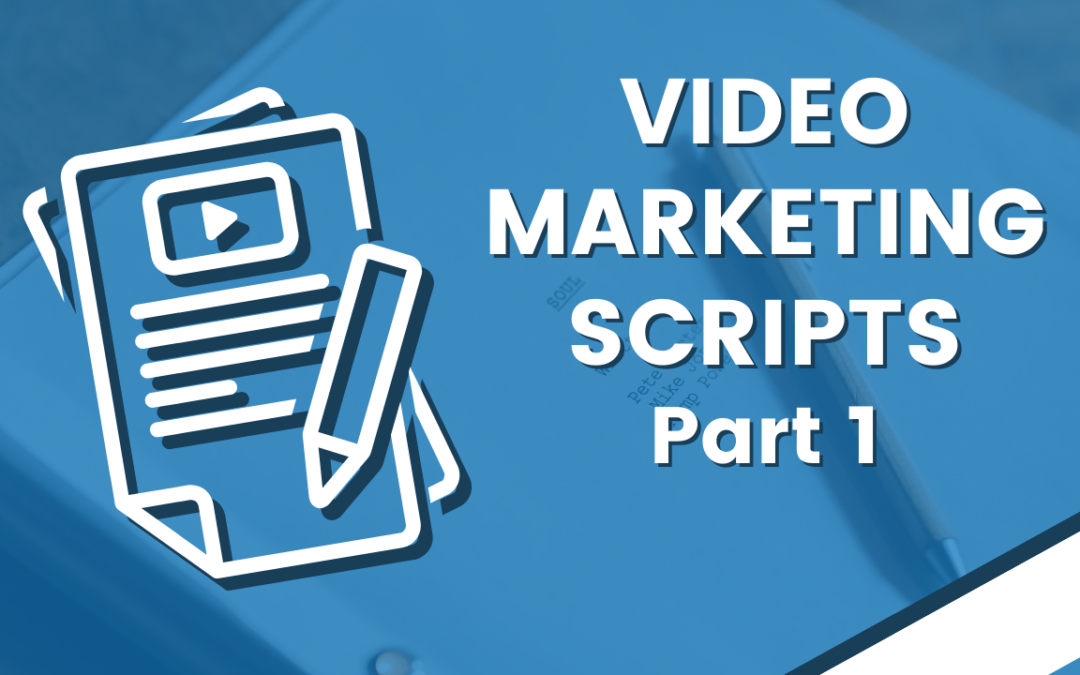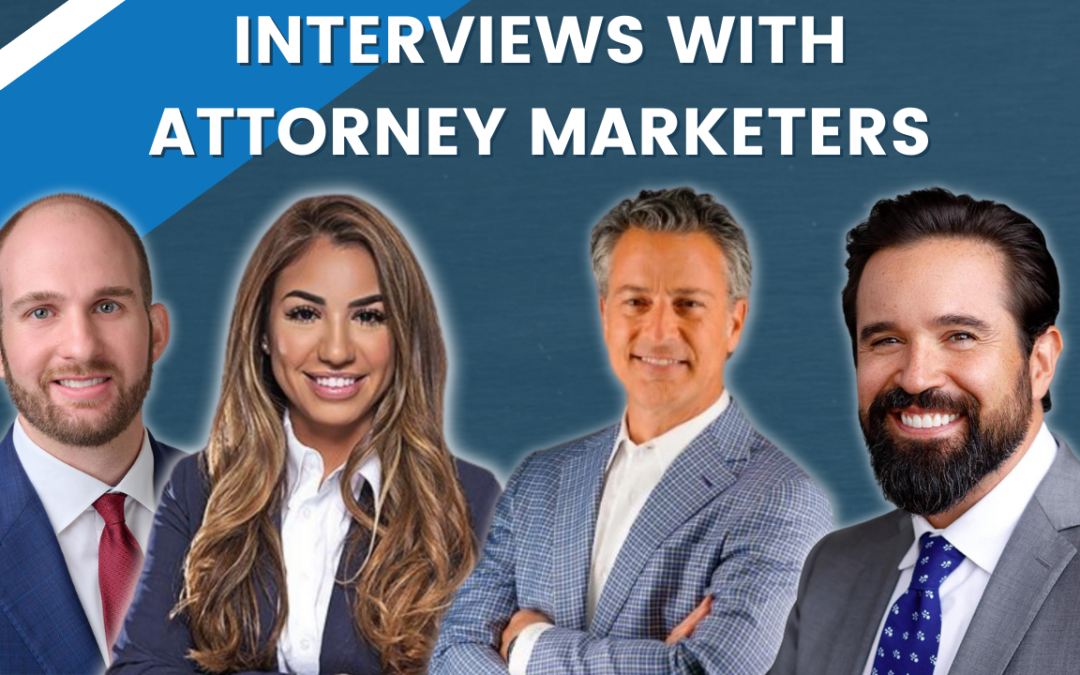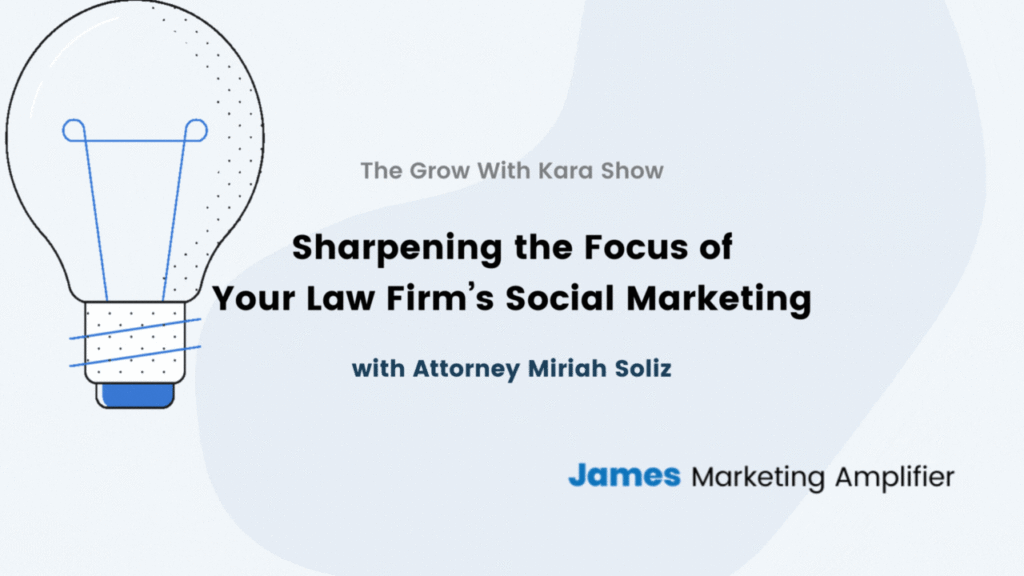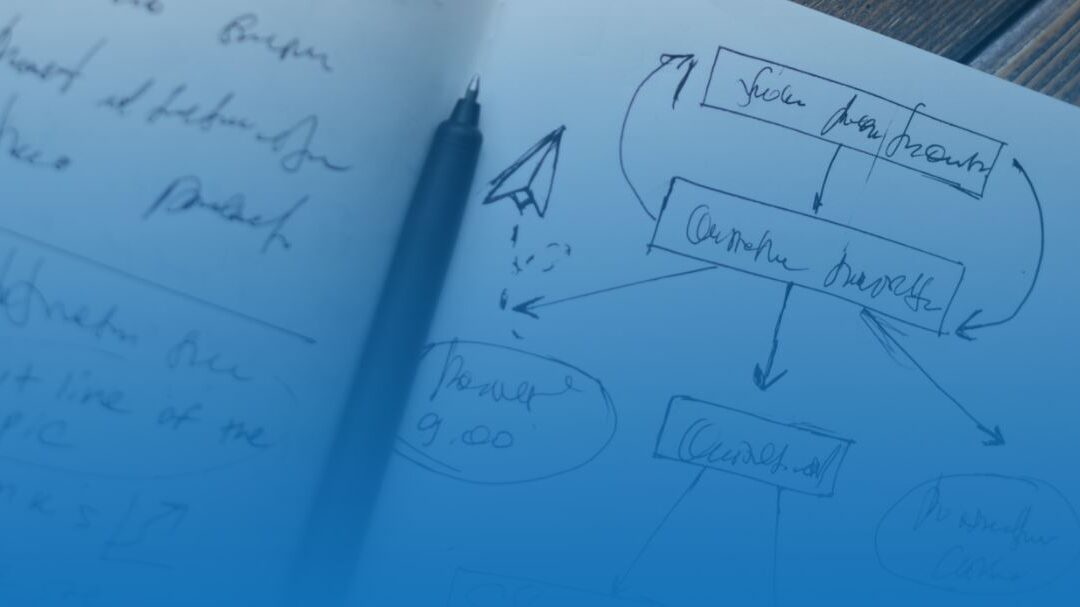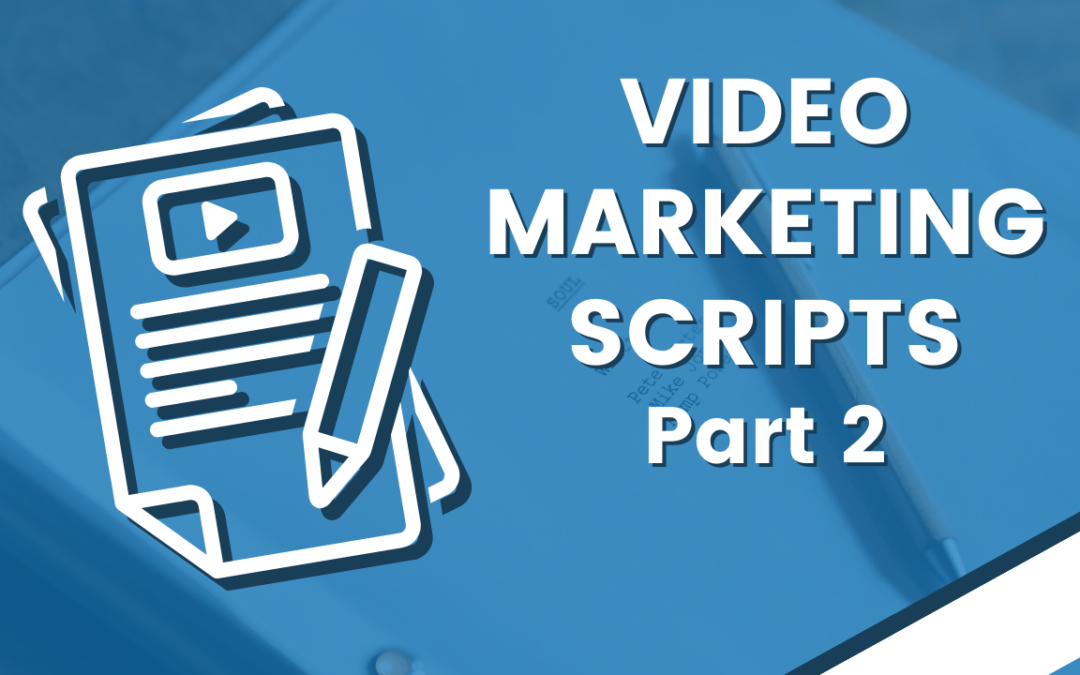
Part 2 Contents: Link back to Part 1 HERE
2B. Partially-scripted videos
2C. Prompts for unscripted videos
2D. Scripts for list videos
2B. Partially-scripted videos
After you have created a few scripted videos, you likely will not need all the structure and guidance that a script provides. Here are a few questions you may want to answer.
Bankruptcy
How are Chapter 7 and Chapter 13 bankruptcy different?
Version 1: Partially scripted:
Short answer: Chapter 7 bankruptcy eliminates most of your unsecured debts. In Chapter 13, you must pay back some of your unsecured debts over three to five years.
Additional Points:
- Chapter 7 trustee sells non-exempt assets.
- Most Chapter 7 filers have no non-exempt assets—keep all/most property.
- Unsecured debts like. . . are eliminated.
- Lasts about 4 months.
- Chapter 13 requires monthly payments.
- Lasts 3 to 5 years.
- Keep all property.
- Costs more than Chapter 7.
Version 2: Fully scripted
Here are three significant differences between them:
- Debt repayment. In Chapter 7 bankruptcy, the bankruptcy trustee sells your non-exempt assets and pays your unsecured creditors some of what you owe. The balance of your unsecured debts is eliminated. If you have no non-exempt assets, you don’t pay anything on your unsecured debts before they are eliminated. In Chapter 13 bankruptcy, you must make monthly payments toward some of your debts. But you keep all your property.
- Duration. Most Chapter 7 bankruptcies are finished within four months. A Chapter 13 bankruptcy lasts for three to five years, the length of your repayment plan.
- Cost. A Chapter 13 case costs more than a Chapter 7 case. Filing fees and attorney fees are higher. And you must pay the Chapter 13 trustee a commission.
How will I know if I’m a good candidate for Chapter 7 bankruptcy?
Version 1: Partially scripted
Short answer: The best way to know if you qualify for Chapter 7 bankruptcy is to discuss your situation with a bankruptcy attorney.
Additional points:
Profile of a good candidate
- Low/modest income.
- Dischargeable debts.
- Little or no non-exempt property.
- No need to cure mortgage or car loan default.
Version 2: Fully scripted
You are probably a good candidate for Chapter 7 if you:
- Have an income below your state’s median or mid-point.
- Have mostly dischargeable debts like credit cards, medical bills, and personal loans.
- Have little or no non-exempt property to lose.
- Don’t need to catch up on a mortgage or car loan to prevent foreclosure or repossession.
These are general rules of thumb. Talk to a bankruptcy attorney for a detailed analysis of your situation.
How will I know if I am a good candidate for Chapter 13 bankruptcy?
Version 1: Partially scripted
Short answer: The best way to know if Chapter 13 bankruptcy is right for you is to discuss your situation with a bankruptcy attorney.
Additional points:
Profile of a good candidate
- Income above state median.
- Mostly non-dischargeable debts.
- Significant non-exempt assets.
- Need to cure a mortgage or car loan default.
- [Want to lien strip second mortgage.
- Eligible for cram down of car loan.]
Version 2: Fully scripted
You are probably a good candidate for Chapter 13 if you:
- Have income above the median income for families your size in your state.
- Have mostly non-dischargeable debts like alimony, child support, taxes, and student loans.
- Have non-exempt assets that you want to keep.
- Want to cure a mortgage or car loan default so that you can keep the property.
These are general guidelines. You should talk to a bankruptcy attorney for a complete analysis of your situation.
Business litigation
What kind of conduct constitutes a breach of a contract?
Version 1: Partially scripted
Technically, any failure to meet one’s obligations under the terms of a contract is a breach of the contract. But, all breaches are not created equal. So, instead of asking, “is it a breach of our contract?” a better question might be: How serious is this breach?
Hello. I’m [state] business litigation lawyer [name]. Today we’re going to talk about the difference between a minor (or “immaterial”) breach of contract and a major (or “material”) breach.
Immaterial breach
- Minor infraction.
- Does not terminate the contract.
Material breach
- Significant failure to perform.
- Aggrieved party can terminate the contract and sue for breach.
Distinguish immaterial v. material based on the terms of the agreement, the circumstances surrounding the breach, and the resulting damages.
[Example]
[Call to action]
Version 2: Fully scripted
Technically, any failure to meet one’s obligations under the terms of a contract is a breach of the contract. But, all breaches are not created equal. So, instead of asking, “Is it a breach of our contract?” a better question might be: How serious is this breach?
Hello. I’m [state] business litigation lawyer [name]. Today we’re going to talk about the difference between a minor (or “immaterial”) breach of contract and a major (or “material”) breach.
An immaterial breach of contract is a minor infraction that does not defeat the purpose of the contract and, consequently, does not terminate the contract; in other words, a contract can survive an immaterial breach. A material breach, on the other hand, is a significant failure to perform on the part of the
breaching party; as a result, the aggrieved party can terminate the contract. Further performance by the aggrieved party is excused, and the aggrieved party has the right to sue for breach of contract.
Whether a breach is material or immaterial will depend on a number of factors, including primarily, the terms of the agreement, the specific circumstances surrounding the breach, and the damage caused by the breach. A court will ask: Did you suffer significant losses, or did you get substantially what you bargained for, despite the technical breach of the agreement?
Let me give you a simple example:
Let’s say you own a building and you contract with a landscaping company to maintain the grounds. The contract states that the grass will be cut every Friday, but the landscaper cuts the grass on Saturday. Cutting the grass on a different day than is specified in the contract is technically a breach of contract, but the grass is still cut. So, if that’s all there is to it, this is likely an immaterial breach. If, however, the contract states that the grass must be cut every Friday because your venue hosts weddings on Saturdays and Sundays, then the landscaper’s failure to cut the grass on Fridays could be a material breach.
If you have concerns about whether a contracting partner is in breach, or the nature of that breach and your legal remedies, call us today to schedule a consultation.
Don’t panic. There are many possible defenses to a breach of contract claim.
Version 1: Partially scripted
Are you facing a breach of contract claim? Don’t panic. A number of different defenses may be available to you.
[Introduction.]
Two-pronged defensive strategy: (1) challenge the elements of the claim and (2) raise affirmative defenses.
Today we focus on challenging the elements of the claim.
Elements of breach of contract are: contract, breach, damages.
Defenses include:
- There was no valid contract (because, e.g., vague terms; violates statute of frauds; unlawful or in violation of public policy);
- There was no breach. Defendant performed its obligations per the contract. ● Plaintiff suffered no damages.
[Call to action.]
Version 2: Fully scripted
Are you facing a breach of contract claim? Don’t panic. A number of different defenses may be available to you.
Hi. I’m [state] business litigation attorney [name].
There are two prongs to defending against a breach of contract claim: (1) Tackle it head-on by challenging the legal elements of the claim; and (2) turn the tables by raising one or more “affirmative defenses.”
Today, we’re going to focus on the first prong. Let’s dive in.
To win a breach of contract claim, the plaintiff (that is, the party accusing you of breach) must prove: ● There was a valid contract;
- The plaintiff performed its obligations under the contract;
- You (the defendant) did not perform; and
- The plaintiff was harmed.
So, in your defense, you could challenge these elements by arguing:
We didn’t have a contract. If there is no valid contract, there can be no breach of contract. A contract might be invalid and, therefore, unenforceable for a number of different reasons, including: ● There was no clear offer and acceptance – no “meeting of the minds”; or
- The law requires the contract to be in writing, but you had an oral agreement; or ● The contract (or the clause sought to be enforced) is unlawful or violates public policy.
Assuming there was a valid contract, your defense might be as straightforward as: There was no breach. You performed all of your obligations, as specified in the contract, in a timely manner.
Alternatively, you might rely on the “no harm, no foul” defense. More specifically, even if you did breach the contract, the plaintiff wasn’t harmed. In business litigation, “harm” usually means financial harm – lost or damaged assets; lost profits; or damage to or loss of a business enterprise. If the plaintiff suffered no financial harm as a result of the breach, then the plaintiff has no claim against you.
These are just some of the defenses that may be available to you, depending on the terms of the contract and the circumstances surrounding the alleged breach. If you’re involved in a contract dispute, call us to discuss your legal options.
Is mediation a good option for resolving a business dispute?
Version 1: Partially scripted
Short Answer: In many cases, yes.
Introduction: Hi. I’m [state] business litigation attorney [name]. A trial is one way to resolve a business dispute, but it may not be the best way. In this video, I’ll explain why mediation might be a good alternative for you and your business.
Preliminary matter:
- Mediation = settlement negotiation that is presided over by a neutral third party called a “mediator.”
- More structured than direct negotiations between the parties; less formal than arbitration or a trial.
Advantages of mediation:
- Mediation is confidential.
- Mediation gives you more control over the outcome of the dispute.
- Juries (and, sometimes, judges) are unpredictable.
- Mediation allows the parties to participate in resolving the dispute; allows for creative solutions.
- Mediation is non-binding.
- Mediator does not impose a resolution
- Parties are free to walk away and have their day in court.
- Mediation is faster than a trial.
- Mediation is cheaper than a trial.
- Mediation allows a sneak peak at the opposing party’s evidence and case strategy. ● Also a potential disadvantage.
- Trust that your lawyer is a smart negotiator, who will reveal enough of your evidence to move toward a settlement, but not so much as to jeopardize your trial strategy.
Call to action.
Version 2: Fully scripted
Is mediation a good option for resolving a business dispute? The short answer to this question, in many cases, is yes.
Hi. I’m [state] business litigation attorney [name]. A trial is one way to resolve a business dispute, but it may not be the best way. In this video, I’ll explain why mediation might be a good alternative for you and your business.
Before we talk about the advantages of mediation, let’s make sure we have the same understanding of what mediation is. Basically, mediation is a settlement negotiation that is presided over by a neutral third party called a “mediator.” It’s more structured than direct negotiations between the parties and their attorneys, but less formal than arbitration or a trial.
Now that we’re on the same page, let’s run through some of the advantages of resolving or attempting to resolve a business dispute through mediation:
First, mediation is confidential. A lawsuit is a matter of public record. Mediation, on the other hand, is a private form of dispute resolution. Nothing you share with the mediator, verbally or in writing, will be made public, and the mediation is closed to everyone except the parties and their counsel.
Second, mediation gives you more control over the outcome of the dispute. A trial is fraught with uncertainty, in large part because jurors (and, sometimes, judges) are unpredictable. Mediation eliminates that uncertainty. It gives the parties an opportunity to participate directly in resolving the dispute and it allows for the possibility of a creative solution – one that meets all of the parties’ needs, but which could not be achieved within the confines of a trial.
Conversely, if the parties cannot reach a negotiated agreement, they are free to walk away have their day in court. This is another advantage of mediation: It’s non-binding, meaning that the mediator cannot force a resolution on the parties or otherwise “fix” the dispute. The parties have control.
Another advantage of mediation is that it’s faster than a trial. A mediation can be scheduled on any date, and at any time and place that is convenient for the parties and the mediator. You don’t have to wait for a spot on a crowded court docket or work around the schedules of experts or other witnesses. Plus, mediation typically is a one-day event. It’s likely to be a very long day, but the mediation process is far more efficient than a trial.
Advantage #5: In part because it’s faster, mediation also is cheaper than a trial.
And, lastly, another advantage of mediation is that it gives your attorney an early look at the opposing party’s evidence and case strategy. Now, your opponent also gets an early look at your evidence and case strategy, which can be a disadvantage, but your lawyer will take great care to reveal no more than is necessary to move the mediation forward and to show that you are ready to win your case at trial if a mediated settlement cannot be reached.
If you have questions about the advantages of mediation we’ve covered in this video, or if you would like to talk more broadly about your options for resolving a business dispute, call us.
Criminal
What does the prosecutor have to prove to convict me of [DWI/DUI/OWI/drunk driving]?
Version 1: Partially Scripted
Short Answer: [Lay out the elements of your state’s statute. E.g.,
The prosecutor must prove each of these elements beyond a reasonable doubt before you can be convicted.
- You [operated or drove] a motor vehicle,
- While [intoxicated by or under the influence of] alcohol,
- On a public road or in a public area.]
Additional Points (briefly explain each element)
- Explain the meaning of “driving” or “operating” in your state.
- Explain meaning of intoxication or how the prosecutor proves it.
- Explain the meaning of public road if relevant in your state or, if not, that you can be convicted even if on private property.
- Mention that prosecution must first establish reasonable suspicion to stop you and probable cause to arrest you.
Version 2: Fully Scripted
The prosecutor must prove each of these elements beyond a reasonable doubt before you can be convicted.
- You [operated or drove] a motor vehicle,
- While intoxicated by or under the influence of alcohol,
- On a public road or in a public area.
[If true in your jurisdiction: If keys are in the ignition and you’re in the driver’s seat, you are operating a vehicle, even if you have not moved it.] [OR, if true in your jurisdiction: The prosecution must prove you actually moved the motor vehicle.]
The prosecutor proves you were [intoxicated/under the influence] with the results from a breath, blood, or urine test and the observations of the officer who arrested you.
A “public road” is one that the public can access and includes places like parking lots of private businesses.
Before offering evidence that you were driving while intoxicated, the prosecutor must first show the police had a reasonable suspicion to stop you and probable cause to arrest you.
How does the prosecutor prove I was [“driving while intoxicated”/”driving under the influence”/or whatever the terminology is in your state]?
Version 1: Partially Scripted
Short answer: The prosecutor can either prove that:
- Your blood alcohol concentration was above the legal limit of [.08] percent. Or
- [You were impaired/did not have the normal use of your faculties because of alcohol /whatever your state statute provides] regardless of your blood alcohol concentration.
Additional Points
- Explain how prosecution proves BAC.
- Explain how prosecutor proves impairment.
Version 2: Fully Scripted
The prosecutor can either prove that:
- Your blood alcohol concentration was above the legal limit of [.08]. Or
- [You were impaired/did not have the normal use of your faculties because of alcohol /whatever your state statute provides] regardless of your blood alcohol concentration.
The prosecutor proves your blood alcohol concentration with the results of a breath, blood, or urine test taken after your arrest. These tests can be untrustworthy and outright wrong. An experienced defense attorney knows how to challenge them in court.
The prosecutor proves [you were impaired/did not have the normal use of your faculties/whatever you state statute provides] with the arresting officer’s testimony. The officer will often testify that you:
- Were driving erratically,
- Smelled of alcohol,
- Had slurred speech, and
- Admitted drinking.
A good defense lawyer has many strategies for persuading jurors that this testimony is not proof beyond a reasonable doubt of intoxication.
What should I do if I am stopped on suspicion of drunk driving?
Short answer: Give the officer your driver’s license and registration. The officer will ask if you’ve had anything to drink and how much. Tell the officer you don’t want to answer any questions until you’ve consulted an attorney. Be polite, respectful, and firm.
Additional Points:
Run through the next usual steps
- Briefly explain field sobriety tests, what they are used for, and advise listeners whether to take them. Presumably not.
- Explain that next step is probably arrest and transport to the station for a breath or blood test.
- Provide whatever advice you typically give on whether to submit to the test and why.
Version 2: Fully Scripted
Give the officer your driver’s license and registration. The officer will ask if you’ve had anything to drink and how much. Tell the officer you don’t want to answer any questions until you’ve consulted an attorney. Be polite, respectful, and firm.
The officer might ask you to perform roadside sobriety tests such as standing on one leg, walking heel to toe, and following a penlight with your eyes. The officer may also ask you to take a preliminary breath test on a portable machine. You can [and should] decline these tests. Police use them to get probable cause to arrest you and present as evidence against you in court.
The officer may arrest you and ask you to take a breath or blood test. If you refuse, your driver’s license will be suspended even if you’re found not guilty. In some jurisdictions, refusing to provide a breath or blood sample is a misdemeanor. Here, in [state] refusal to submit to a chemical test [is/is not] a misdemeanor.
Estates
What are the advantages of using a trust to leave an inheritance to a minor?
Version 1: Partially Scripted
Short Answer: Of all the options for leaving an inheritance to a minor, a trust gives you the
most control over the terms of your gift.
Additional Points:
– You control distributions and can impose conditions on the gift.
– You decide when to terminate the trust. Termination after age 18 is ok.
– Termination can be stages.
– Trust property is protected from creditors.
Version 2: Fully Scripted
Short Answer: Of all the options for leaving an inheritance to a minor, a trust gives you the
most control over the terms of your gift.
– You tell the trustee how to use the trust assets. The trustee is usually given discretion to use
trust assets for the beneficiary’s health, education, maintenance, and support. But you can
impose additional conditions. For example, you could instruct the trustee to withhold
distributions if the child drops out of school or does some other undesired activity.
– A trust can protect the assets from a beneficiary’s creditors, impulsive spending, or division
to a beneficiary’s spouse in a divorce. Creditors can get at the assets once they are distributed
from the trust, however.
– You can keep your gift in trust after the beneficiary turns 18. You may not want the trust to
end until the beneficiary is 25 or even 30. Termination can be staggered, so that the beneficiary
receives half the trust estate at 25 and the rest at 30, for example.
The challenge of estate planning for blended families
Version 1: Partially Scripted
Short Answer: You’re married or about to marry and you have children from a prior marriage or relationship. One estate planning challenge you likely face is how to balance the needs and expectations of your spouse with those of your children.
Additional Points:
– Spouses in first marriages often leave their estates to each other.
– Why that puts children’s inheritance at risk in blended families.
– How spousal inheritance rights allow a surviving spouse to thwart the deceased spouse’s plan to benefit children.
– Assure listeners that planning can overcome these problems.
– Briefly mention tools that can be useful in blended family estate planning. Version 2: Fully Scripted
You’re married or about to marry and you have children from a prior marriage or relationship. One estate planning challenge you likely face is how to balance the needs and expectations of your spouse with those of your children.
In a first marriage, spouses often leave their estates to each other. Each assumes the survivor will use the inheritance for their family and leave what’s left to their children.
This arrangement doesn’t work for the blended family.
If you leave your estate to your spouse, she may decide to leave nothing to your children. If your spouse dies without an estate plan, her relatives will inherit everything she owns.
If, on the other hand, you decide to leave most of your estate to your children, your spouse may thwart your plan. The law in most states gives a surviving spouse the right to claim a minimum percentage of a deceased spouse’s estate.
With careful planning, you can solve these problems. It’s possible to both provide for a surviving spouse and protect your children’s inheritance. With tools like trusts, life insurance, prenuptial and post-nuptial agreements, an estate planning attorney can show you how.
What qualities should I consider in choosing a guardian for my children?
Version 1: Partially Scripted
Try to choose someone who:
– Shares your values and beliefs. . . .
– Can provide the children with love and emotional support. . .
– Has financial resources to raise them if necessary. . .
– Is young and healthy enough to raise them. . .
– Won’t require the children to re-locate. . .
– Has good character; no drug, alcohol problems, or significant criminal history. . .
Version 2: Fully Scripted
You’ll probably want to choose someone with whom you have shared values, religious beliefs, goals, and parenting styles.
Try to choose someone your children know and feel comfortable with and who loves your children and will nurture them. Unless you can provide substantial assets, choose someone with the financial resources to raise your children.
Select someone who is sufficiently young and healthy to care for your children until they reach adulthood. You may want to choose your parents. Consider whether they have the stamina for child rearing and the possibility that they could die while the children are still minors.
If possible, select a guardian who lives nearby or who is willing to relocate to where the children live.
Be careful not to choose someone that a court wouldn’t approve, such as a person who has abused drugs or alcohol or who has a criminal record.
Family
What is a no-fault divorce?
Version 1: Partially Scripted
Short Answer: The “no-fault” standard to dissolve a marriage requires you (or your spouse) to testify that [your marriage is irretrievably broken or whatever the statutory language is in your jurisdiction]. That is, you and your spouse can do nothing to salvage the marriage. Neither spouse has to prove the other’s fault caused the divorce.
Additional Points:
- Allowed in all states.
- No need to prove misconduct caused breakdown.
- Fault is irrelevant except [describe exceptions, e.g., impaired parent, assets wasted on affair, or whatever is appropriate for your state].
- Pre-filing separation period may be required in some states. [Mention rule in your state re pre-filing separation if there is one.]
Version 2: Fully Scripted
The no-fault standard to dissolve a marriage requires you (or your spouse) to testify that [your marriage is irretrievably broken or whatever the statutory language is in your jurisdiction]. That is, you and your spouse can do nothing to salvage the marriage. Neither spouse has to prove the other’s fault caused the divorce. All states allow no fault divorce.
Fault has no impact on property division, alimony, or custody, except in limited circumstances. [For example, a spouse’s substance abuse may be relevant in a custody case. A spouse’s diversion of marital assets to finance an affair may affect the property division. Or use examples pertinent to your state.]
Some states require a couple to live apart for a time before filing for a no fault divorce. [State rule in your state.]
Can my spouse prevent me from getting a divorce?
Version 1: Partially Scripted
Short answer: Your spouse can’t stop your from getting a no fault divorce. But, by refusing to cooperate, he or she can make the process longer, more expensive, and more acrimonious.
Additional points:
Mention how lack of cooperation can delay divorce and increase cost:
- Need for process server.
- Failure to participate in good faith in settlement negotiations or mediation.
- Refusal to settle.
- Need for a trial.
Version 2: Fully Scripted
Your spouse can’t stop you from getting a no fault divorce. But he or she can make the process longer, more expensive, and more acrimonious.
You‘ll probably need to pay a process server to have your spouse formally served. If your spouse doesn’t answer the divorce [complaint/petition], you can get a default divorce.
If your spouse answers, he or she can make settlement negations difficult and protracted. If your spouse refuses to settle, you’ll need to appear before a judge for a trial. Your spouse must be notified of the date, but the court can grant your divorce even if he or she decides not to show up.
Do I need a lawyer to get a divorce?
Version 1: Partially Scripted
Short answer: You can represent yourself. But that is not a good idea unless you have a simple uncontested case.
Additional Points:
DIY best for:
- Short marriage.
- No kids.
- Little property.
- Both people self-supporting.
- Agree on property and debts.
Hire attorney to review final agreement.
Version 2: Fully Scripted
You can represent yourself. But that is not a good idea unless you have a simple uncontested case.
Do-it-yourself divorces are best when:
- The marriage is short;
- You don’t have children;
- You don’t own real estate and have little other property;
- You are both capable of supporting yourselves;
- You agree on how to divide your property and debts; and
Even if you fit into this category, you may want to hire an attorney to look over your final agreement.
You need an attorney if you have any other issues. These could include: custody, child support, division of debts and assets, alimony, a family-owned businesses, or out-of-state property, to name but a few.
Personal injury
How much is my personal injury case worth?
Version 1: Partially Scripted
Short answer: The value of your personal injury case will depend, in large part, on the answers to the following seven questions:
#1. Whose fault was it?
#2. What is the nature and severity of your injuries?
#3. What story is told in your treatment records and medical bills?
#4. How strong is your evidence of lost income?
#5. Do you pass the “likeability” test?
#6. How strong are your witnesses?
#7. How much time has passed since the injury-accident?
Version 2: Fully Scripted
Short Answer: The value of your personal injury case will depend, in large part, on the answers to the following # questions:
#1. Whose fault was it?
- Who is to blame for the injury accident?
- Comparative fault: Is the defendant’s fault greater than yours?
- As your responsibility approaches 50%, the value of your case drops significantly.
#2. What is the nature and severity of your injuries?
- Right or wrong, some injuries are worth more than others.
- Readily documented and confirmed by objective evidence (e.g., a broken arm) or soft-tissue injury supported by subjective complaints of pain?
- Permanent or transitory?
- Prior injury to same body part?
#3. What story is told in your treatment records and medical bills?
Your case is worth more if:
- You sought treatment right away
- Your treatment well-documented and proportionate to your claimed injuries
- Your medical bills match your treatment records
#4. How strong is your evidence of lost income?
- How much have you lost in wages/salary/profits?
- Is this amount easily calculated, documented, and verifiable?
- If not (e.g., if you are self-employed or a gig worker), your claim is worth less.
#5. Do you pass the “likeability” test?
- If your case were to go to trial, would jurors like you more than the defendant?
- Would jurors empathize with your situation?
#6. How strong are your witnesses?
#7. How much time has passed since the injury-accident?
- General rule: The more time that passes, the lower the value of your case.
- Jury will find it harder to empathize with you if your injuries have long since healed and you have returned to your normal life.
- Insurers know this and will delay settlement as long possible.
Should I talk to the other driver’s insurance company?
Version 1: Partially Scripted
No. As a general rule, you should never talk to the other driver’s insurance company.
If you have filed an insurance claim following an auto accident, you may get a call from the other driver’s insurance company. Here are four things you need to know about that call:
- The claims adjuster is not on your side.
- You do not have to talk to the adjuster.
- You do not have to give a recorded statement.
- You do not have to sign anything or allow the insurance company access to your medical records.
Bottom line: The entire purpose of this call is to gather evidence that can be used against you. Refer the adjuster to your insurance company or attorney.
Version 2: Fully Scripted
Short Answer: No. As a general rule, you should never talk to the other driver’s insurance company.
If you have filed an insurance claim following an auto accident, you may get a call from the other driver’s insurance company. Here are four things you need to know about that call:
- The claims adjuster is not on your side.
- Adjuster works for the insurance company.
- Adjuster’s job is to save the insurance company money, not to get you a fair settlement.
- You do not have to talk to the adjuster.
- Not required by law, rule, regulation or contractual obligation.
- Against your interests to talk.
- You do not have to give a recorded statement.
- Goal of a recorded statement: To lock you into one specific set of facts and use your statement against you.
- Against your interests to give a recorded statement. Don’t do it.
- You do not have to sign anything or allow the insurance company access to your medical records.
- Do not sign a records release or agree to allow access to your medical records.
- Insurance company releases are broad, to allow for a fishing expedition.
- Goal: To find evidence to use against you.
Bottom line:
- The entire purpose of this call is to gather evidence that can be used to lower the value of your claim and reduce your settlement.
- Smartest course of action: Say nothing; politely, but firmly, tell the adjuster to contact your insurance company or your personal injury attorney; end the call.
Do I have a strong slip, trip and fall case?
Version 1: Partially Scripted
Short Answer: The strength of your slip/trip and fall case will turn on the legal issue of liability, or fault. If the property owner/manager is at fault for the accident (or, at least, more at fault than you) and you have evidence to prove that, then you have a strong slip/trip and fall case.
Let’s learn more:
- Claims adjusters tend to be skeptical of slip/trip and fall claims and claimants.
- Adjuster will look for ways to shift some (or even all) of the blame to you.
- Factors the claims adjuster will weigh in determining liability:
- External factors, e.g., lighting, weather.
- Walking surface.
- Statements and official reports.
- Photos/videos.
- Owner’s knowledge of the hazard.
- Your conduct and decisions leading up to the slip/trip and fall.
Conclusion: Liability is rarely crystal clear. The more these factors weigh in your favor, the stronger your case will be and the more likely you are to obtain full and fair compensation for your injuries.
Version 2: Fully Scripted
Short Answer: The strength of your slip/trip and fall case will turn on the legal issue of liability, or fault. If the property owner/manager is at fault for the accident (or, at least, more at fault than you) and you have evidence to prove that, then you have a strong slip/trip and fall case.
Let’s learn more:
- Claims adjusters tend to be skeptical of slip/trip and fall claims and claimants.
- The adjuster is likely to drag his feet and make a lowball offer unless you have convincing evidence that it was the property owner’s negligence – and not your own carelessness – that caused you to slip or trip and fall.
- Adjuster will weigh the following factors in assessing who was at fault:
- External factors, e.g., lighting, weather.
- Condition of the walking surface, e.g., flat and dry or uneven, steep, slippery, etc.
- Statements, e.g., eyewitnesses, accident reports, police reports, sweep logs, EMT records.
- Admissions. Did anyone apologize or admit fault at the scene?
- Photos/videos.
- Whether the owner knew or should have known of the hazard and failed to remedy it, e.g., a history of falls or complaints about the condition of the property; posted warnings; repairs/modifications.
- Your conduct and decisions leading up to the slip/trip and fall, e.g., What shoes were you wearing? Were you carrying something that obstructed your view of the walkway? Were you watching your step or were you distracted or talking or looking at your phone? Had you been drinking? Were you on medication?
Conclusion:
Liability is rarely crystal clear in a slip/trip and fall case. The greater your perceived fault, the weaker your case will be. On the other hand, the more these factors weigh in your favor, the stronger your case will be and the more likely you are to obtain full and fair compensation for your injuries.
Social Security disability
Can I be denied disability benefits if I fail to follow my doctor’s treatment plan?
Version 1: Partially Scripted
Short Answer: Yes. If the treatment your doctor prescribed would have restored your ability to work, then your claim will be denied, unless you can prove that you had “good cause” for not following your doctor’s orders.
If you are otherwise eligible for disability benefits, but you refused to follow your doctor’s prescribed treatment plan, SSA will look for answers to two questions:
- Would the treatment prescribed by your doctor have improved your condition to the extent that you could return to full-time work?
and, if so,
- Did you have “good cause” for failing to follow the prescribed treatment?
Would the treatment have allowed you to work?
- Treatment means medication, surgery, therapy, and medical equipment and assistive devices (like a cane or prosthetic).
- Treatment does not mean recommended lifestyle changes.
- If treatment would NOT have restored your ability to work, then the issue is closed and you will be awarded benefits.
- If treatment WOULD HAVE restored your ability to work, then you will have to answer this question:
Did you have “good cause” for refusing to follow the treatment plan your doctor prescribed?
Examples of SSA-approved “good cause”:
- Conflicting medical opinions
- Alternative prescribed treatment
- Religion
- Incapacity
- Intense fear of surgery.
- This same prescribed treatment has failed in the past (aka been there, done that).
- Cost.
- High risk of loss of life or limb.
- Risk of opioid addiction
- Other reasons
We can help.
If “failure to follow a prescribed treatment” is an issue in your case, you have two options:
- Challenge the claim that you failed to follow your doctor’s orders; or
- Persuade Social Security that you had good cause.
We can help you gather additional evidence to overcome this hurdle and win benefits.
Version 2: Fully Scripted
Short Answer: Yes. If the treatment your doctor prescribed would have restored your ability to work, then your claim will be denied, unless you can prove that you had “good cause” for not following your doctor’s orders.
This is important, so let’s dig a little deeper.
If, after reviewing your claim, Social Security determines that you meet all the criteria to be awarded disability benefits, but there is evidence in your file that you refused to comply with your doctor’s prescribed treatment plan, then your claim might be denied. The outcome of your claim will depend on the answers to these two questions:
Would the treatment prescribed by your doctor have improved your condition to such an extent that you could return to full-time work?
and, if so,
Did you have “good cause” to reject the treatment?
In this context, treatment includes medication, surgery, therapy, and medical equipment and assistive devices (like a cane or prosthetic). It does not include broad recommendations that you change your lifestyle. For example, if your doctor recommends that you exercise more, or eat more vegetables, or stop smoking, that does not count as prescribed treatment, and you will not be penalized if you fail to do so.
If Social Security concludes that the prescribed treatment would not have restored your ability to work, then that’s the end of the inquiry. Your reasons for rejecting that treatment are irrelevant, and you will be awarded benefits.
However, if Social Security finds that the treatment your doctor prescribed would have allowed you to return to work, then you will have to answer the next question: Did you have “good cause” for refusing to follow the treatment plan your doctor prescribed?
According to Social Security, you have good cause to reject a prescribed course of treatment if:
- Your doctors do not agree, and you get conflicting medical opinions about the wisdom of following the prescribed treatment; or
- Your doctors offered different treatment options, so you chose one and rejected the others; or
- Your religion does not allow you to follow the prescribed treatment; or
- You do not have the mental capacity to fully understand the consequences of refusing treatment; or
- You have an intense and very real fear of undergoing surgery; or
- You already have tried the prescribed treatment and it didn’t work; or
- You can’t afford the prescribed treatment; or
- The prescribed treatment is too risky – so risky that you fear you might die or lose a limb or vital organ; or
- The prescribed treatment includes opioids, and you won’t risk becoming addicted.
This is not an exclusive list. If you have another reason for refusing to go along with your doctor’s treatment plan, Social Security will consider it.
If “failure to follow a prescribed treatment” is an issue in your case, you have two options: Challenge the claim that you failed to comply with your doctor’s plan or persuade Social Security that you acted with good cause in refusing to go along. Either way, you will have to present additional evidence in support of your claim. We can help you gather the evidence you need to get over this hurdle and win the benefits you deserve. Call us if you’d like to talk about your situation.
What is the “compassionate allowances” program and how does it work?
Version 1: Partially Scripted
Short Answer: The Compassionate Allowances program is a way for Social Security to quickly get disability benefits to the claimants with the greatest need. The same rules and procedures apply to Compassionate Allowances claims as to other claims for disability benefits, but these claims are evaluated, processed and approved at a faster rate.
Let’s learn more.
Why “Compassionate Allowances”?
- The CA program helps Social Security identify claimants whose condition is dire and fast-track their applications for benefits.
- Important because the SSA bureaucracy moves slowly.
- Reality is that some claimants can’t wait the many months that it typically takes to get a decision on their claim.
How does it work?
“Compassionate Allowances” list:
- 200+ diseases/conditions that are plainly severe enough to meet the SSA definition of “disabled,” e.g., neurodegenerative disorders (like ALS), brain disorders, numerous cancers, and rare diseases.
- Many of the diseases/conditions are terminal; all have significant and difficult symptoms.
- Some conditions (e.g., many cancers on the list) have a severity threshold.
If your impairment is on the list:
- Your application will be flagged for CA review; no special application or extra forms required.
- Your claim must be supported by objective medical evidence, but the quantum of evidence required is much less –just enough for Social Security to confirm your diagnosis.
- CA review can take as little as a week for approval of your claim, assuming, of course, that you have the required medical evidence.
- Average processing time is 19 days.
Questions? Call us today.
Version 2: Fully Scripted
Short Answer: The Compassionate Allowances program is a way for Social Security to quickly get disability benefits to the claimants with the greatest need. The same rules and procedures apply to Compassionate Allowances claims as to other claims for disability benefits, but these claims are evaluated, processed and approved at a faster rate.
Let’s learn more.
The Compassionate Allowances program helps Social Security identify claimants whose condition is dire and fast-track their applications for benefits. This is important because the Social Security bureaucracy moves slowly. Practically speaking, this means that most people have to wait months – sometimes more than a year – to get a decision on their claim for benefits. Some claimants, however, don’t have that much time. It is in recognition of this reality that Social Security created the Compassionate Allowances program.
It works like this:
Social Security has compiled a list of more than 200 diseases and conditions that clearly are severe enough to meet its definition of “disabled.” The “compassionate allowances” list includes neurodegenerative disorders (like ALS), brain disorders, and numerous cancers, as well as rare diseases. Many of the diseases and conditions on the list are known to be terminal, and all of them present daily symptoms that are extremely difficult to deal with. Some of the conditions on the list have a severity threshold you must meet to qualify. For example, some cancers on the list require that your cancer has metastasized or is inoperable or unresectable (i.e., it cannot be completely removed via surgery) and that, even with treatment, your prognosis is poor.
If your impairment is on the list, your application will be flagged for compassionate allowances review. You don’t have to file any special application or complete any additional forms.
Social Security will evaluate your claim using the same criteria that it uses to evaluate every other claim for benefits. And, as with any other claim, you will need to present objective medical evidence in support of your claim. However, the amount of evidence you need to provide for a compassionate allowances condition is far less than for a condition that is not on the list — just enough for Social Security to confirm your diagnosis. Nothing more is required.
Once your application is flagged for compassionate allowances review, it can take as little as a week for your application to be approved, assuming, of course, that your medical evidence is in order. The average processing time is 19 days.
Questions?
If you have questions about whether your claim might qualify for compassionate allowances review, call us today. We can help.
Tip: Keep an asthma journal to monitor your symptoms and your “peak expiratory flow”
Version 1: Partially Scripted
If you’ve been diagnosed with asthma, you may be able to obtain disability benefits if your condition is severe enough to prevent you from working.
Asthma claims can be challenging because:
- Symptoms ebb/flow
- May be well controlled with medication
- Asthma journal can help you build a strong claim.
Use your asthma journal to:
- Track your symptoms;
- Identify triggers;
- Describe the impact of your symptoms on your daily life; and
- Measure and record your peak expiratory flow.
“Peak expiratory flow” (or “PEF”)
- Measures how open/constricted your airways are
- Peak flow meter
- Peak flow test:
- How to? “Fast blast”
- Measures how much air you are able to expel in one forceful exhalation
- Useful for self-monitoring and taking proactive role in treatment
Now, back to your journal.
- Any form is acceptable
- Guidelines:
- Use your own words;
- Make regular entries;
- Include regular (even daily) PEF readings;
- Be honest; and
- Be specific.
Conclusion: PEF scores and journal entries work together to provide additional information SSA needs to more accurately assess the severity of your asthma and the extent to which it prevents you from working.
Questions? We can help.
Version 2: Fully Scripted
If you’ve been diagnosed with asthma, you may be able to obtain disability benefits if your condition is severe enough to prevent you from working.
Asthma claims can be challenging because asthma symptoms tend to ebb and flow in response to various triggers and often can be well controlled with medication.
You can build a stronger claim and improve your odds of winning benefits by keeping an asthma journal.
Use your asthma journal to:
- Track your symptoms (e.g., tightness in your chest, shortness of breath, wheezing, coughing, etc.);
- Identify possible asthma triggers (things like dust, cold air, exercise);
- Describe the impact of your asthma symptoms on your daily life; and
- Measure your peak expiratory flow and record the results.
Let’s talk for just a minute about peak expiratory flow. “Peak expiratory flow” (or “PEF”) is a means of assessing how open or constricted your airways are. To measure your PEF you need a small, hand-held device called a “peak flow meter.” This meter allows you to do peak flow tests from home. A peak flow test is a simple, painless, “fast blast” test. You just blow into the meter, and it measures how much air you are able to expel in one forceful exhalation. A peak flow test is a good way to self-monitor your symptoms and take a proactive role in your healthcare and your asthma treatment.
Now, back to your journal.
Your asthma journal can take any form that works for you: a handwritten diary; a computer log; a spreadsheet; or even a large desk calendar. Whatever form you choose, follow these guidelines to get the maximum benefit from your journal:
- Use your own words;
- Make regular entries in your journal and be sure to include regular (even daily) PEF readings;
- Be honest. Don’t exaggerate your symptoms; and
Be specific. A detailed journal is a persuasive journal.
Your PEF scores and your journal entries, together, should paint a vivid picture of the impact of your symptoms on your daily life over an extended period of time. This information will help Social Security more accurately assess the severity of your asthma and the extent to which it prevents you from working.
If you have questions about how to get started, or other concerns about your asthma claim, call us. We can help.
2C. Prompts for unscripted videos
Once you have moved from reading scripts word-for-word to using partial scripts or just bullets, and feel more comfortable speaking in front of a camera, consider answering questions like the ones provided below.
The questions can be:
– Posed by a person off-camera who you respond to
– Spelled out on a slide that appears before your answer
– Asked verbally by you before you answer
However you begin, once you can shoot without a script your videos will appear more natural and will be more engaging.
Bankruptcy
Hi, I’m ____ from the Law Offices of ____. We’re a {specialty} firm serving the _____ area. Many clients want to know more about {topic}, so that’s what I’m going to discuss with you today
[Section 1. For your website’s about page.]
___ What led you to the law and to representing financially distressed individuals? [We are seeking here to personalize and humanize you, and to build a connection with your viewers. Is there something in your upbringing or past that stands out as a draw to helping people put their financial problems behind them? Can you tell a story that illustrates that pull? If you have a team helping you, mention their assistance.]
[Section 2. For your website’s about page.]
___ What are the most rewarding aspects of your work?
[Here we want to convey your enthusiasm for and dedication to your calling. What gets you excited about coming into the office? What makes you feel you and your firm are making a contribution to society and a difference in people’s lives?]
[Section 3. For your website’s home page. Pick one.]
___ How do you help people?
[Tell us about the condition of financial affairs which new clients bring to you, and then the position they leave after you have helped them. Maybe as an illustration you can tell a story about a particularly-compelling fact pattern that will appeal to your ideal client. And perhaps we can weave in some of your firm’s testimonials and recommendations.]
___ What about your approach to helping people is your firm especially proud of? [Is there something distinctive about your approach? Is it especially personal and communicative? Or are you streamlined and automated, getting the job done efficiently and promptly? Or maybe it comes from being especially selective about clients so you can devote considerable personal attention to each client’s challenges?]
___ What can a new client expect once you agree to take them on? [Explain how your service unfolds. Perhaps you can illustrate one or more of the intellectually-challenging aspects of handling a client’s bankruptcy so that the prospective client thinking about using Nolo or internet forms understands the task may not be as simple as envisioned.]
Business litigation
Hi, I’m ____ from the Law Offices of ____. We’re a {specialty} firm serving the _____ area. Many clients want to know more about {topic}, so that’s what I’m going to discuss with you today
[Section 1. For your website’s about page. Pick one.]
___ What led you to the law and to representing businesses involved in disputes? [We are seeking here to personalize and humanize you, and to build a connection with your viewers. Is there something in your upbringing or past that stands out as a draw to helping people resolve their business disputes? Can you tell a story that illustrates that pull? If you have a team helping you, mention their assistance.]
___ What are the most rewarding aspects of your work?
[Here we want to convey your enthusiasm for and dedication to your calling. What gets you excited about coming into the office? What makes you feel you and your firm are making a contribution to society and a difference in people’s lives?]
[Section 2. For your website’s home page. Pick two.]
___ How do you help businesses and their owners?
[Tell us about the situations which new clients bring to you, and then the position they leave after you have helped them. Maybe as an illustration you can tell a story about a particularly-compelling fact pattern that will appeal to your ideal client. And perhaps we can weave in some of your firm’s testimonials and recommendations.]
___ What about your approach to helping people is your firm especially proud of? [Is there something distinctive about your approach? Is it especially personal and communicative? Or are you streamlined and automated, getting the job done efficiently and promptly? Or maybe it comes from being especially selective about clients so you can devote considerable personal attention to each client’s challenges?]
___ What can a new client expect once you agree to take them on?
[Explain how your service unfolds. Perhaps you can illustrate one or more of the intellectually-challenging aspects of handling a business dispute so that the prospective client thinking about going it alone understands the task may not be as simple as envisioned.]
Criminal
[Section 1. For your website’s about page.]
___ What led you to the law and to representing those charged with crimes? [We are seeking here to personalize and humanize you, and to build a connection with your viewers. Is there something in your upbringing or past that stands out as a draw to helping people caught up in the criminal justice system? Can you tell a story that illustrates that pull? If you have a team helping you, mention their assistance.]
[Section 2. For your website’s about page.]
___ What are the most rewarding aspects of your work?
[Here we want to convey your enthusiasm for and dedication to your calling. What gets you excited about coming into the office? What makes you feel you and your firm are making a contribution to society and a difference in people’s lives?]
[Section 3. For your website’s home page. Pick one.]
___ How do you help people?
[Tell us about the condition of situations which new clients bring to you, and then the position they leave after you have helped them. Maybe as an illustration you can tell a story about a particularly-compelling fact pattern that will appeal to your ideal client. And perhaps we can weave in some of your firm’s testimonials and recommendations.]
___ What about your approach to helping people is your firm especially proud of? [Is there something distinctive about your approach? Is it especially personal and communicative? Or are you streamlined and automated, getting the job done efficiently and promptly? Or maybe it comes from being especially selective about clients so you can devote considerable personal attention to each client’s challenges?]
___ What can a new client expect once you agree to take them on? [Explain how your service unfolds. Perhaps you can illustrate one or more of the intellectually-challenging aspects of handling a client’s criminal charges so that the prospective client thinking about using a public defender understands the drawbacks.]
Estates
Hi, I’m ____ from the Law Offices of ____. We’re an estate-planning firm serving the _____ area. Many clients want to know more about {topic}, so that’s what I’m going to discuss with you today
[Section 1. For your website’s about page.]
___ What led you to the law and to helping people?
[We are seeking here to personalize and humanize you, and to build a connection with your viewers. Is there something in your upbringing or past that stands out as a draw to helping people put their affairs in order? Can you tell a story that illustrates that pull? If you have a team helping you, mention their assistance.]
[Section 2. For your website’s about page.]
___ What are the most rewarding aspects of your work?
[Here we want to convey your enthusiasm for and dedication to your calling. What gets you excited about coming into the office? What makes you feel you and your firm are making a contribution to society and a difference in people’s lives?]
[Section 3. For your website’s home page. Pick one.]
___ How do you help people?
[Tell us about the condition of financial affairs which new clients bring to you, and then the position they leave after you have helped them. Maybe as an illustration you can tell a story about a particularly-compelling fact pattern that will appeal to your ideal client. And perhaps we can weave in some of your firm’s testimonials and recommendations.]
___ What about your approach to helping people is your firm especially proud of?
[Is there something distinctive about your approach? Is it especially personal and communicative? Or are you streamlined and automated, getting the job done efficiently and promptly? Or maybe it comes from being especially selective about clients so you can devote considerable personal attention to each family’s estate?]
___ What can a new client expect once you agree to take them on?
[Explain how your service unfolds. Perhaps you can illustrate one or more of the intellectually-challenging aspects of organizing a client’s estate so that the prospective client thinking about using Nolo or internet forms understands the task may not be as simple as envisioned.]
Family
How do you communicate with clients and keep them informed about what’s happening in their cases?
[Do you:
− Give clients a phone number to reach you? Or an email address?
− Prefer phone calls or email?
− Have a legal assistant or secretary they can call if you are unavailable?
− Send them regular updates? How often? (some attorneys write brief progress notes on their bills)
− Copy them on all letters, pleadings, memos, etc.
How long does it take you to respond to client calls and emails?
Add any advice you have for clients about keeping up with their cases and in touch with their lawyer.]
Besides law school, do you have any other training or experience that has made you a better family law attorney?
[Here you might talk about, for example:
− The regular CLE you take or teach.
− Whether you are a certified specialist and what was involved in getting the credential, − Awards you have earned and professional organizations you are active in.
− Whether you are also trained as a mediator, therapist, counselor, accountant, etc. − Experiences from a previous job or career.
− Your divorce, if you are divorced.
− Your experiences as a parent.
You could even talk about your experience with a particular client or case that had an impact on the way you practice or a person who mentored or trained you. ]
Can you describe your most challenging/memorable/rewarding case?
[This can kick off your collection of case-specific videos.]
Personal injury
Hi, I’m ____ from the Law Offices of ____. We’re a {specialty} firm serving the _____ area. Many clients want to know more about {topic}, so that’s what I’m going to discuss with you today
[Section 1. For your website’s about page.]
___ What led you to the law and to representing the injured?
[We are seeking here to personalize and humanize you, and to build a connection with your viewers. Is there something in your upbringing or past that stands out as a draw to helping the injured? Can you tell a story that illustrates that pull? If you have a team helping you, mention their assistance.]
[Section 2. For your website’s about page.]
___ What are the most rewarding aspects of your work?
[Here we want to convey your enthusiasm for and dedication to your calling. What gets you excited about coming into the office? What makes you feel you and your firm are making a contribution to society and a difference in people’s lives?]
[Section 3. For your website’s home page. Pick one.]
___ How do you help people?
[Tell us about the condition in which new clients come to you, both physically and mentally, and then the position they leave after you have helped them. Maybe as an illustration you can tell a story about a particularly-compelling case that will appeal to your ideal client. And perhaps we can weave in some of your firm’s testimonials and recommendations.]
___ What about your approach to helping people is your firm especially proud of? [Is there something distinctive about your approach? Is it especially personal and communicative? Or are you streamlined and automated, getting the job done efficiently and promptly? Or maybe it comes from being especially selective about case acceptance so you can devote serious effort to each case?]
___ What can a new client expect once you agree to take their case? [Explain how a case unfolds. Perhaps you can illustrate one or more of the challenging aspects of obtaining a fair settlement with a story about when an insurer dug in its heels and what it took to drag them to the negotiating table. The purpose of this illustration is to persuade the
prospective client thinking of handling his/her own negotiation that the job may not be as simple as envisioned.]
Social Security disability
Hi, I’m ____ from the Law Offices of ____. We’re a {specialty} firm serving the _____ area. Many clients want to know more about {topic}, so that’s what I’m going to discuss with you today
[Section 1. For your website’s about page. Pick one.]
___ What led you to the law and to representing disabled individuals? [We are seeking here to personalize and humanize you, and to build a connection with your viewers. Is there something in your upbringing or past that stands out as a draw to helping people unable to work? Can you tell a story that illustrates that pull? If you have a team helping you, mention their assistance.]
___ What are the most rewarding aspects of your work?
[Here we want to convey your enthusiasm for and dedication to your calling. What gets you excited about coming into the office? What makes you feel you and your firm are making a contribution to society and a difference in people’s lives?]
[Section 2. For your website’s home page. Pick two.]
___ How do you help people?
[Tell us about the situations of the new clients who come to you, and then the position they leave after you have helped them. Maybe as an illustration you can tell a story about a particularly-compelling fact pattern that will appeal to your ideal client. And perhaps we can weave in some of your firm’s testimonials and recommendations.]
___ What about your approach to helping people is your firm especially proud of? [Is there something distinctive about your approach? Is it especially personal and communicative? Or are you streamlined and automated, getting the job done efficiently and promptly? Or maybe it comes from being especially selective about clients so you can devote considerable personal attention to each client’s challenges?]
___ What can a new client expect once you agree to take them on?
[Explain how your service unfolds. Perhaps you can illustrate one or more of the intellectually-challenging aspects of handling a client’s appeal so that the prospective client thinking about going it alone understands the task may not be as simple as envisioned.]
2D. Scripts for list videos
In the text world, these are called “listicles.” They have their own name because they are so popular with information consumers.
They draw people because they:
— Require minimal effort to consume
— Curate information
— Convey authority
— Are entertaining
Bankruptcy
7 Steps to Rebuilding Your Credit After Bankruptcy
Many people who could benefit from bankruptcy hesitate to file because they believe it will take years, even decades, to rebuild their credit. Not so. You can rebuild your credit after bankruptcy, probably sooner than you think, if you exercise self-discipline and take a step-by-step approach:
Step 1: Clean up your credit report.
Lenders rely on your credit report when deciding whether to extend credit to you, so you want to make sure it is accurate. Look for errors like these:
- An outstanding balance on an account that was discharged in bankruptcy;
- Late payment notations when you paid on time;
- Closed accounts that are listed as open;
- Paid accounts listed as unpaid; or
- Duplicate entries.
If you find an error, report it and follow up until it is corrected.
Step 2: Create a budget and stick to it.
Rebuilding your credit requires self-discipline, and discipline demands a budget. Once you know your monthly expenses as compared to your monthly income, you can begin to make smarter financial decisions.
Step 3: Make a habit of paying all your bills on time.
Establish a bill-paying routine and be disciplined about following through with it each month. A strong payment history will be the most important factor in raising your credit score.
Step 4: Apply for new credit.
You need to establish new credit in order to build credit and generate a FICO number. There are several ways to do this. You could:
Obtain an unsecured credit card. You will probably receive multiple credit card offers when your bankruptcy is completed. Why? Because banks know you cannot file for bankruptcy again for several years, and they can sue you and garnish your wages if you default. Read the fine print before you sign anything.
Become an authorized user on an unsecured credit card. Because the cardholder is responsible for paying the bill, you don’t even need to use the card to bolster your credit, as long as the bank is reporting the card activity to the credit bureaus.
Apply for a secured credit card. It works like this: You deposit a sum of money into a bank account and that sum, or a percentage of that sum, becomes your credit limit. To boost your credit score, charge small amounts each month and pay the balance in full and on time.
Apply for a secured loan. This works like a secured credit card. For example, you agree to leave $500 in your savings account, in exchange for a loan of $500.
Another way to establish new credit is to obtain an installment loan. One type of installment loan you may be able to get is an auto loan. Some lenders will extend this type of credit to individuals within a few months of bankruptcy discharge.
Step 5: Make timely payments and keep your balance low.
As I’ve mentioned, your payment history is a critical piece in establishing your credit score. So, once you obtain new credit, pay your bill on time and in full. If a zero-balance is not possible, then keep your balance at or below 30% of your credit limit.
Step 6: Take a measured approach to building new credit.
A rush to open multiple new lines of credit in a short period of time will undermine your efforts to rebuild your credit. Keep the number of credit accounts you open to a minimum – just one or two — and spread your applications over time.
Step 7: Check your credit score and monitor your credit report.
Check your credit score regularly, and check your credit report every six-to-nine months. Make sure any newly obtained credit is being tracked consistently and accurately.
So, to sum up: Although a bankruptcy can stay on your credit report for up to ten years, you can minimize the negative impact in about 18 months if you are disciplined in your approach to your finances. The key will be to establish a strong payment history and to keep your credit card balance low, relative to your spending limit.
Business litigation
6 Factors a Business Lawyer Will Consider in Evaluating Your Case
Do I have a case?
I’m asked that question often, by business owners trying to figure out what exactly they are dealing with. A dispute surely is brewing, but is it a misunderstanding that might be resolved with a phone call or two, or is it a more serious issue that might justify a lawsuit?
To help you assess whether legal action makes sense, we’ll consider a number of different factors, starting with liability. Is the other party to the dispute liable – that is, legally responsible – for the harm you and your business have suffered? To put it another way, can you hold the other party accountable under one or more legal theories, such as breach of contract, or unfair competition or fraud? If liability is clear, you have a stronger case. If liability is questionable, or if the other party could raise an affirmative defense or a counterclaim that would excuse it from liability or limit your damages, then your case is weaker.
That brings us to the next factor we’ll consider: your damages. “Damages” is the legal term for the harm your business has suffered as a result of the other party’s wrongful conduct. If your business suffered no harm, then you likely have no case, even if the defendant’s liability is clear. If the damages are speculative or uncertain, then you may have a case, but your case is weaker than if your damages are readily quantifiable. Lost profits, for example, are easier to quantify than is harm to your business’ reputation.
A third factor we’ll consider in evaluating your situation is the potential defendant. Does the potential defendant have assets to satisfy a judgment and/or insurance that might be applied to a settlement? If not, you and I both could invest a great deal of time, money and effort in pursuing your claim and end up with a “win” in name only, without you ever seeing any actual compensation for the harm done to you.
Another factor we consider is the strength of your evidence, including your “jury appeal.” Do you have documents that support your case? How strong are your witnesses? How strong of a witness will you be? To put it more bluntly: Will a jury like you? Even if your case never gets to trial, your jury appeal is important because the insurance company will consider it in valuing your case for settlement.
Forum issues also must be considered. Where would a lawsuit be filed? In federal court or state court? If state court, in which state? This issue may be governed by the terms of a contract or, in the absence of a contract provision, we may have a choice about where to file a lawsuit, which could work to your advantage. Likewise, if your dispute arises from a written contract, the contr act may include an arbitration provision that bars you from seeking relief in court. Even without a mandatory arbitration clause, some form of alternative dispute resolution – like mediation or settlement negotiations between the parties – might be favorable to letting a jury resolve the matter.
Finally, the last factor we consider in evaluating whether and what type of legal action makes sense is you and your mindset. Resolving a business dispute can be expensive, time-consuming and physically,
mentally and emotionally draining, especially if we have to file a lawsuit. Are you prepared to take this journey?
If you are dealing with a business dispute, you don’t have to worry over it alone. Call us. We can assess your legal options in light of the case evaluation factors we’ve discussed here and help you determine your next best step.
Criminal
3 Effective Drunk Driving Defenses
#1. Improper stop
The police cannot stop a car at random hoping to catch an impaired driver. The officer must have a reasonable, articulable suspicion of unlawful conduct. Isolated incidents of weaving or other “bad driving” are not always enough for a legal stop.
#2. No probable cause to arrest
The officer must have probable cause to believe the driver is under the influence.
The officer may claim that the driver had bloodshot eyes, slurred speech, or an unsteady gait. These behaviors may have innocent explanations like fatigue, illness, or anxiety.
The officer may claim the driver failed field sobriety tests. Field sobriety tests are difficult for most people to pass. Police often administer them incorrectly. Poor performance can be explained by injury, footwear, roadside conditions, or nerves.
#3. Untrustworthy test results
Test results can be questioned. Police and lab personnel do not always follow proper testing procedures. The breath machine can malfunction. Falsely high results can be caused by medical conditions, injuries, the timing of the test, and other factors. Blood samples can be contaminated if not properly collected, preserved, and stored.
When supported by the facts, these defenses can lead to dismissal of the case, a favorable plea deal, or a not guilty verdict.
Estates
5 Goals You Can Accomplish with an Estate Plan
Caption: #1. You decide who gets your property.
Narration: An estate plan lets you decide who gets your property after you die. If you die without an estate plan, state law determines who gets your property and in what shares. The state’s plan may not be what you want. For example, the state scheme will not let you:
- Leave unequal shares of your estate to your children.
- Disinherit a child.
- Leave property to a spouse for life and then to children from a prior marriage.
- Leave a gift to a grandchild, more distant relative, life partner, or friend.
- Leave a gift to charity.
Caption: #2 You can avoid probate.
Narration: An estate plan lets you avoid or minimize the delay and expense of probate. Probate, the court-supervised process of distributing your estate, can be time-consuming and expensive. You can eliminate probate or minimize the assets that need to be probated with estate planning techniques such as a revocable living trust, transfer on death deeds, and beneficiary designations.
Caption: #3 You can choose a guardian for your children.
Narration: An estate plan lets you choose a guardian for your minor children and a person to manage their inheritance. If you and your children’s other parent are dead or incapacitated, a court will appoint a guardian for them. Usually, the court will appoint the person you choose in your will. If you don’t name a guardian, family members could fight over the job. The court could name someone you don’t trust.
Caption: #4 You can provide for your incapacity.
Narration: An estate plan lets you provide for your incapacity. With a durable power of attorney, you can choose a person to manage your finances if you are incapacitated. With a health care power of attorney, you can choose a person to make medical decisions for you when you no longer can. In a living will, you can provide written guidelines about what type of end-of-life treatment you want.
Caption: #5 You can minimize estate taxes.
Narration: An estate plan lets you minimize estate taxes. If you have a substantial estate, your estate plan can incorporate tax-saving trusts. A bypass trust ensures both spouses fully use their estate tax exemptions. A marital deduction trust avoids estate tax when the first spouse dies. An irrevocable life insurance trust removes life insurance proceeds from an insured’s estate, and other irrevocable trusts transfer wealth from a parent’s estate without giving the child beneficiary immediate control over assets.
Family
7 Ways to Protect Your Assets During Divorce
Divorce is a stressful and life-changing event. Although you may feel you have little control over the process, there are some things you can do to safeguard your interests and ensure you come out of the process in a financially stable position.
(1) Do not confuse “protecting” your assets with “hiding” your assets. You can protect your assets from being dissipated, but you cannot hide your assets to keep them from your spouse. Any “hidden” assets will not stay hidden for long. A savvy private investigator will find them, and the court will punish you for your deception.
(2) Know what you have. Create a record – a detailed list or a video inventory – of the contents of your home on a particular day. Note the location and the condition of each item.
(3) Make copies of important financial records. Make three copies of your important records – financial statements, tax returns, deeds, etc. Give one copy to your spouse; give one copy to your attorney; and store the third copy in a safe deposit box or other secure location away from your home.
(4) Begin to establish financial independence. Open a separate checking account, in your name only, if you do not already have one. Talk with your spouse and your divorce attorney about closing joint bank accounts and canceling joint credit cards; as a group, determine how best to share the funds and apportion the debt.
(5) Be vigilant. Check your credit report regularly so that you will not be caught off guard by a loan application, or charges to a new credit card, or other activity. Put a freeze on any joint savings or investment accounts; obtain and review regular statements for these accounts.
(6) Don’t overlook retirement plans and life insurance. If your spouse has a pension plan, retirement account, or life insurance in his or her own name, obtain a current statement and a copy of the plan.
(7) Don’t make emotional decisions. You can be emotional about your divorce, but not about your financial decisions. Decisions of this magnitude are best made with the advice of knowledgeable and experienced professionals – a divorce attorney, a tax attorney, a financial planner.
Seek professional advice before making any major financial decisions during your divorce.
Personal injury
10 Topics Your Personal Injury Attorney Will Discuss With You at Your First Meeting
Your first meeting with a personal injury attorney is an information-gathering session. To determine whether you have a viable case, the attorney will ask questions and talk with you about these ten topics:
- Your background;
- The event that caused your injuries;
- The nature and severity of your injuries;
- Your medical providers and treatment history;
- Your medical history;
- Your accident history;
- Your present employment situation;
- Insurance coverage that might be available to you;
- Witnesses to the injury-accident; and
- The impact of the injury-accident on your enjoyment of life.
Though these questions may feel intrusive, everything you tell the attorney is confidential. Therefore, it is important to be open and honest with the attorney, in order to get an accurate assessment of your situation.
Caption
Topic #1: Your Background
Narration
First, your attorney will gather some basic background information including: your full name; your age; your address and contact information; your marital and family situation; your education history; and your employment history.
Having gathered this background information, your attorney will move on to questions about the injury-accident.
Caption
Topic #2: The Event That Caused Your Injuries
Narration
When asked about the injury-accident, provide as much information as you can, and be as detailed and specific as possible. What was the date of the accident? At what time of day did the accident occur? What were you doing before the accident occurred? What do you remember about the accident itself? What do you remember about the immediate aftermath of the accident?
Caption
Topic #3: The Nature and Severity of Your Injuries
Narration
Next, your lawyer will ask about injuries to various parts of your body. Do not be shy. Describe the nature of your injuries and the symptoms you experienced and continue to experience as a result of the accident. For example, you might say:
My head hit the steering wheel, and I sustained a concussion and a large bump and gash on my forehead. The gash on my head was painful, and the concussion symptoms lingered for months. Even today, I still experience headaches and dizziness. I rarely leave the house anymore because I’m so embarrassed by the giant scar on my forehead.
Your lawyer will ask about your recovery and your prognosis for the future. Be honest. Try not to exaggerate or minimize your situation.
Caption
Topic #4: Your Medical Providers and Treatment History
Narration
Now that you have described your injuries, your lawyer will want to know about all of the medical treatment you have received in relation to the injury-accident, including who provided the treatment and where. All treatment includes emergency treatment at the scene, as well as subsequent treatment provided at a hospital or clinic by a physician, surgeon, radiologist, physical therapist, psychologist or counselor, etc. Because this information is so important, your lawyer will ask pointed questions and want detailed answers. You may find it helpful to create a list of your medical providers ahead of time and bring this list with you to refresh your memory.
Caption
Topic #5: Your Medical History
Narration
Your personal injury lawyer will want to know about any significant events or issues in your medical history. Your lawyer may ask, for example, “Prior to this injury-event, were you a generally healthy person?” “Have you sustained any injuries (regardless of the cause) to the same part of your body that was injured in this accident?” “How was that injury resolved?”
Caption
Topic #6: Your Accident History
Narration
Expect your lawyer to ask questions like: Have you been in any prior accidents, whether or not you were injured? Did you file an insurance claim in relation to that accident? How was that claim resolved? Have you ever filed for Social Security disability or workers’ compensation?
Caption
Topic #7: Your Present Employment Situation
Narration
Another topic of conversation will be your current employment situation and how your injury has affected your ability to work. For example, your lawyer might ask: Who is your employer? What is your income? What type of physical activity is required to do your job? How much time have you lost from work? Do you anticipate losing more work time? What work-related losses have you suffered as a result of this incident; for example, have you lost income? benefits? a promotion? training opportunities? etc.?
Caption
Topic #8: Insurance Coverage
Narration
If you have information about the defendant’s insurance coverage (that is, coverage that might be available to you through the person who caused your injuries), bring that with you to the meeting. In addition, share with your lawyer information about all potentially available insurance coverage you have, including auto, health, and homeowner’s.
Caption
Topic #9: Witnesses
Narration
Objective witnesses can play an important role in proving your personal injury case. Can you identify any eyewitnesses to the incident? Can you think of anyone else (not an eyewitness) who might be a potential witness? Think, for example, about a “before and after” witness who could testify about how the accident and your injuries have changed you.
Caption
Topic #10: Loss of Enjoyment of Life
Narration
One final topic your lawyer is likely to discuss with you is the physical, mental and emotional impact of your injuries on your daily life. Your lawyer will ask, for example, “What were you able to do before the accident that you are not able to do now, or are able to do only with difficulty or pain?”
Social Security disability
5 Tips to Improve Your Chances of Obtaining SSD Benefits
Hi, I’m ____ from the Law Offices of ____. We’re a {specialty} firm serving the _____ area. Many clients want to know more about {topic}, so that’s what I’m going to discuss with you today
Today I’m going to share with you five things you can do to improve your chances of obtaining Social Security disability benefits.
#1. Pay attention to the paperwork.
Social Security will ask you to provide a great deal of personal information and complete a small mountain of paperwork in support of your application for disability benefits. The whole process can feel unnecessarily intrusive and more than a little overwhelming. However, it’s critical that you comply with these requests. If you fail to complete the required forms accurately and promptly, or if you provide limited or incomplete information, especially with regard to your medical providers, your claim is likely to be denied or, at best, any award of benefits will be delayed.
#2. Be a good patient.
One of the most important things you can do in support of your claim for disability benefits is to take care of your health. See your treating doctor regularly. Follow through with all prescribed treatment plans and do not stop treatment until you are released by your doctor. Disability benefits are awarded to individuals who have a severe physical or mental impairment that is diagnosed by a medical professional and supported by objective medical evidence. If your medical records reveal lengthy gaps in treatment or that you stopped treatment altogether, your claim is likely to be denied.
#3. Keep a contemporaneous record of your medical care.
Social Security will gather your medical records in support of your initial application for disability benefits, but if your claim is denied, you will have the opportunity to present additional medical evidence in support of your appeal. This will be easier to do, and far less stressful for you, if you keep good records from the outset. Here are some ways you might do this:
- Set up a folder to hold all documents related to your medical treatment.
- Keep a separate calendar just for medical appointments.
- Collect a business card from every doctor or medical facility you visit.
- Keep your receipts and empty prescription bottles for all medications you take.
#4. Keep a symptom diary.
A symptom diary is a written record of the nature and severity of your symptoms and the impact of your symptoms on your daily life. This record can be critical to the success of your claim because it will help you provide detailed, compelling testimony at your hearing, even if (as is likely) the hearing takes place many months after your initial application is denied. To get the maximum value from your symptom diary, follow these guidelines:
- Make regular entries;
- Use your own words;
- Be honest; and
- Provide details that paint a picture of the impact of your impairment on your daily life.
Finally,
#5 Be persistent.
Most initial applications for Social Security disability benefits are denied, as are most written requests for reconsideration. However, the odds favor the persistent. More than half of the individuals who appeal their claim to a hearing before an Administrative Law Judge are awarded benefits.
So, if your claim is denied, don’t give up. Appeal!
Your denial letter will explain the appeal process, but if you have questions or concerns, reach out to an experienced Social Security disability attorney without delay. You have only a limited time in which to file an appeal.
All of these tips are effective and simple (but not necessarily easy) ways to bolster your claim. If you would like more information, or if you have questions about Social Security disability, call us at ###-###-#### to schedule a free consultation.




